How do you construct a ultra-modern city around historical sites and buildings that have been around for over 600 years? And you have to do it in such a fashion that it doesn’t damage the foundational structure and the look and feel of an ancient city? Not only that, you have to build a vast network of underground subway trains that spreads out to all corners of the city to help move millions of its citizens and improve traffic conditions up top? I don’t know anything about city planning but I’m sure it’s not an easy task. I know there are those who are critical of what today’s Seoul looks like, but I think the city officials did an admirable job, at minimum.

Couple of weeks before we came to Seoul, the three of us were making a list of things to do and places that we couldn’t miss this time. For me, the National Museum was at the top, and for my second daughter it was the Hanbok (한복) experience at Gyeongbokgung Palace (경복궁). You see, for many foreign tourists and locals alike, wearing Hanbok to the Royal Palace of Joseon Dynasty has become very Instagram-worthy.

Hanbok is of course the traditional Korean wear that you see all the time in the K-dramas. It literally means, “Korean Clothing.” The city of Seoul and the people managing Gyeongbokgung instituted a brilliant bylaw allowing anyone who wears Hanbok to the popular tourist attraction to enter free of admission. Granted, it’s only 3,000 KRW (~$2.50 in USD) but it’s had enormous impact on the local economy and in providing a cultural experience like none other for tourists, as we shall see.
Again, I’m having problems with editing photos with my old laptop, so I’ll just have to explain without numbering things. The main gate at the front of the Palace is 광화문 (Gwanghwa-mun) and you have to go through 2 additional “gates” to get to the main hall called 근정전 (Geunjeong-jeon) where the King and the officials met everyday to discuss the topic of the day. The big building on the back left is 경회루 (Gyeonghwae-roo), where royal festivities were held.
But first, to the far right as you walk past the main gate Gwanghwa-mun, is the admission ticket office (small structure on the front right of the above picture), where it says…
… general admission is 3,000 KRW and when the “Free Guided Tours” are scheduled. Hard to see, but it also says that if you are wearing Hanbok, the admission is free.
At the second gate (or the first after Gwanghwa-mun), there is this. The panel is self-explanatory. The three of us proudly strutted to the left—I would venture a guess and say that the percentage of people who donned Hanbok at the Palace was about 50%—all rentals at nearby shops. Foreign tourists seemed to be completely immersed in the experience—all smiles and picture-taking at every possible angle despite the record-breaking heat/humidity wave that’s been lingering on for more than 30 days straight.
Before we move on, some information about Hanbok rental. Around Gyeongbokgung, there are many, many Hanbok rental shops—google “hanbok rental” and you’ll see a whole list of them. Hanbok being the admission ticket to the Palace having an economic impact I alluded to earlier? The shop owners are benefitting “big-ly.”
I chose the one that’s the closest to Gyeonbokgung’s front entrance (= Gwanghwa-mun), called Cham Hanbok (참한복). They also happened to offer the lowest rates at 15,000 KRW (~$12 USD) for a 90-minute rental for what they call “premium” Hanbok.
As it’s shown on their website (on the Korean language page), there are over 2000 Hanboks to choose from—everything from the official King and Queen’s garb to a sword-wielding General to princesses, court entertainers, to average middle-class commoners.
You are given 30 minutes to choose—the 90-minute rental doesn’t start until you’re ready to go—and there are very kind ladies who make suggestions, help you choose, and with the fitting. They spoke okay English too. When we were there, we were the ONLY Koreans (legally Americans).
They have extra services, like braiding your hair Joseon style for 5,000 KRW (~$3.50), renting the appropriate head pieces for 3,000 KRW. It wasn’t a cookie-cutter service either—they took great care in preparing my kids’ hair and trying on different decorative pieces.
And here they are.
On the left is my youngest of the three, and on the right is the middle child who didn’t want her bangs touched. They themselves picked out the whole look, and I was genuinely, and very pleasantly, surprised with how well they wore it.
So we enter Gyeongbokgung through the Hanbok entrance and get to the main hall where the King’s throne is displayed.
I guess it all depends on the viewer’s perspective, but Gyeongbokgung doesn’t feel like a “Palace,” nor does this throne seem imposing, at all. I mean that in the most positive sense—it’s not overly extravagant nor “I’m-the-son-of-the-god”ly.
In my previous posting about Korean Architecture, I’ve written that the Korean philosophy on building Royal Palaces was based on…
儉而不陋 華而不侈 (검이불루 화이불치, gum-ih-bool-loo hwa-ih-bool-chi)
Frugal but not shabby, exalted but not extravagant. (there are different versions of the translations, and this is my own.)
I believe that the way Gyeongbokguk was designed and built, it perfectly fits this description.
Because of the heat and the 90-minute time limit, we didn’t spend too much time in the Palace. We visited only a few structures, one being the Geunjeong-jeon (the above Main Hall) and the other being Gyeonghwae-roo.
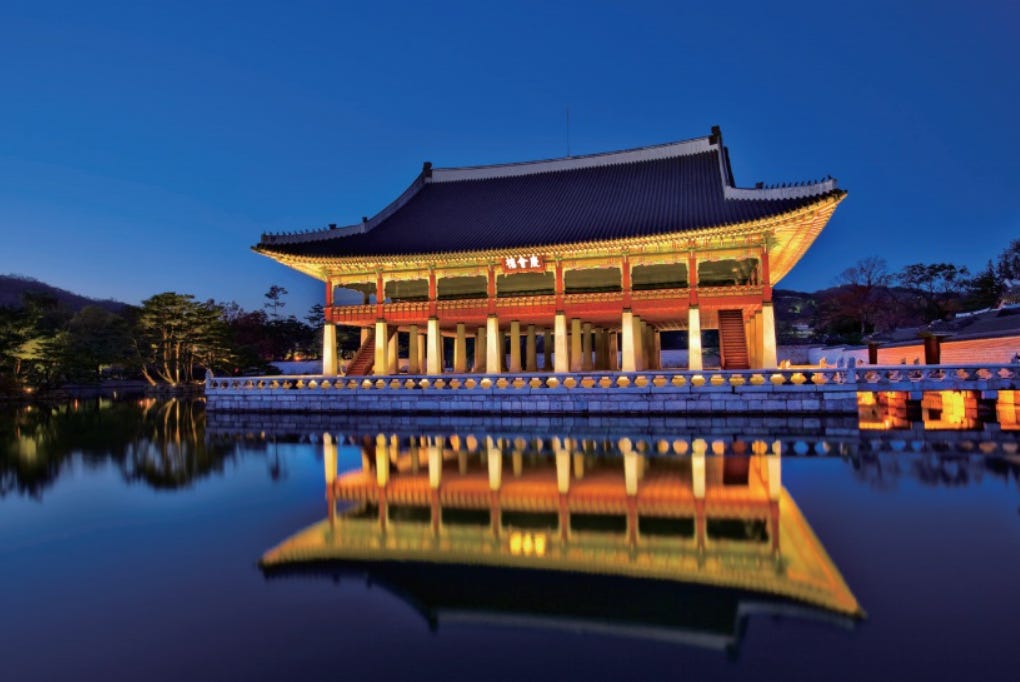
Probably the most picturesque part of the whole Palace, this structure, which is bigger than Geunjeong-jeon and sits in the middle of an artificial pond, was built to house royal parties and festivities when foreign (Chinese, mainly) diplomats would visit.
And you finally get to see my mug, with my navy Converse Chuck Taylors blending in as if it were a natural part of the Hanbok. (Thank you to the Australian couple who were gracious enough to take this picture for us. A proud and lucky dad? You bet.)
Simply awesome experience, beautiful to look at, and great at covering up a body in desperate need for hard personal training (in case you hadn’t noticed, I’m talking about me), but two huge drawbacks of Hanbok. 1). No pockets! 2). Not very heat resistant. I think we each downed 2 glasses of iced tea at a nearby cafe afterwards.
There is a well-known and well-followed Professor of Korean Art History named Yoo Hong-joon (유홍준), who has written a series of best-selling books on the Korean art and historical artifacts spread out across the country. He is even highly respected in North Korea—they invited him to come up and write about the North Korean sites, which he gladly obliged to. He is a great orator and a story-teller. I can listen to him talk all day. Anyway, when he was put in charge of the Korea Heritage Service, a government wing that oversees the national treasures and historical artifacts, one of the first things he did was to visit Gyeongbokgung and walk the grounds when it was closed.
He asked the head of security walking with him who has worked there for over 30 years, “when is Gyeongbokgung the prettiest?” The answer, Professor Yoo admits, came to him completely unexpected.
When it rains and there are no visitors, you sit on the ground level at the southeast corner of the courtyard and see the rainwater flow through the creases of the stone pavement.

Something Prof. Yoo never, ever, has even thought of, with all of his knowledge and experience, he said. So he actually waited for a rainy day and did exactly as he was told—where to sit and what time of day. He firsthand saw the dreamlike imagery of rainwater slowly, randomly, and unevenly flowing through to the drainage and realized something—all the books in the world couldn’t tell you the real hidden beauty only a person who sees it everyday can experience. So, he pleaded to his viewers. Get out there. Go visit.
It indeed is something I would love to see one day (but probably won’t be able to).




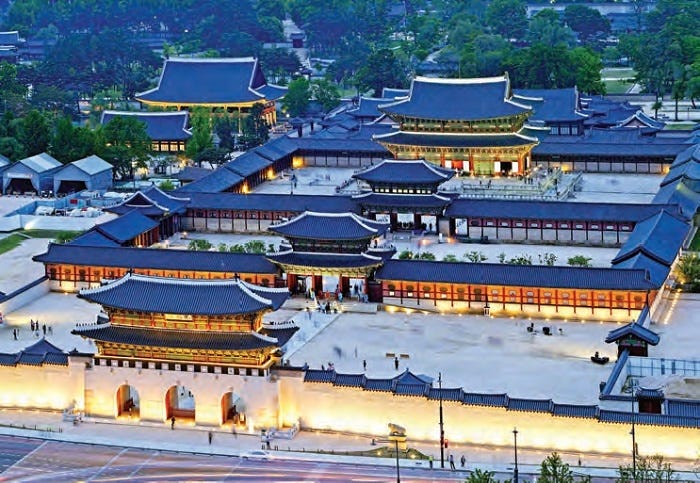




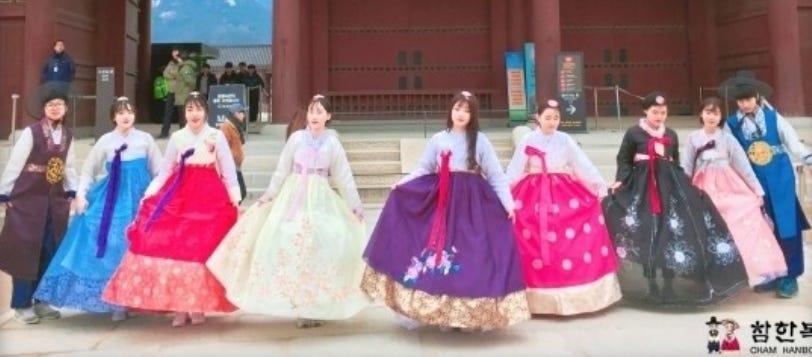





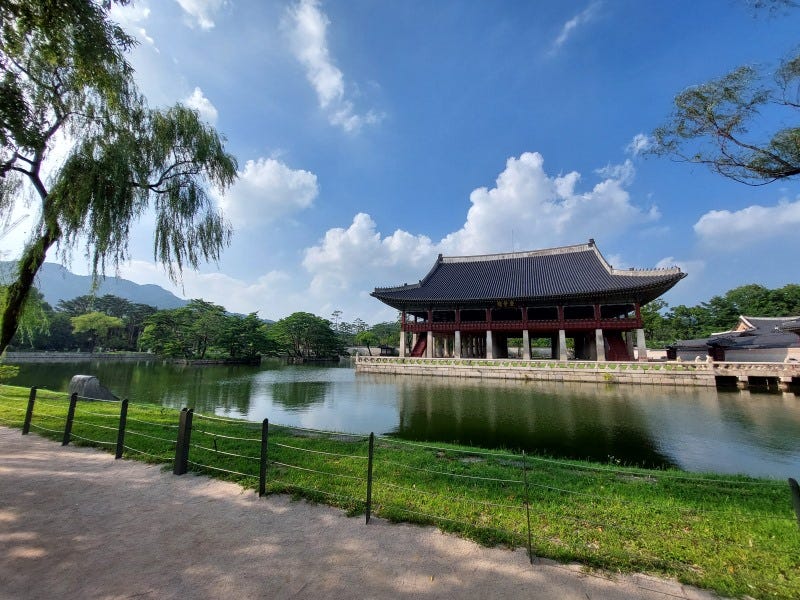
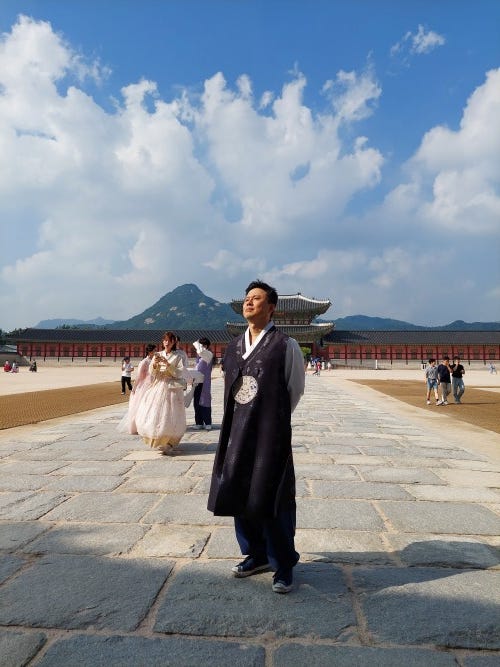

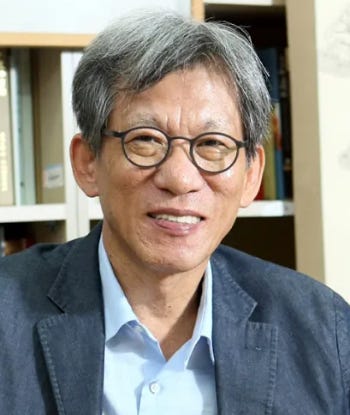
Thank you for the photos of Hanbok, the palace and part of your lovely family. You and the girls are having a great memorable visit. Your storytelling is enjoyable (and informative).